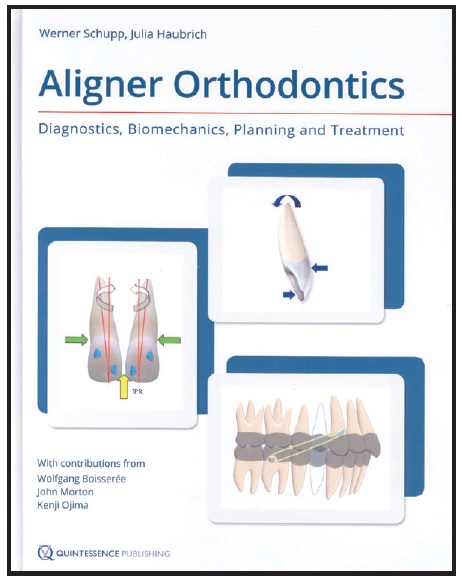BOOK REVIEW
Aligner Orthodontics: Diagnostics, Biomechanics, Planning and Treatment
WERNER SCHUPP, DDS, PhD
JULIA HAUBRICH, DMD
368 pages, 2,000 illustrations. $228. 2015.
Quintessence Publishing Co., Inc., 4350 Chandler Drive, Hanover Park, IL 60133.
(800) 621-0387; www.quintpub.com.
Clear-aligner therapy has gained popularity since the advent of Invisalign, to the point that it is often requested by potential patients. Although some practitioners still question the accuracy of the technique, this book offers a detailed protocol of diagnosis and treatment planning designed to improve the efficiency of aligner therapy.
Chapter 1 is an overview of comprehensive diagnosis, from chief complaint to TMJ examination and mounted cast analysis. Reminding the reader that a thorough diagnosis is the key to an efficient treatment plan - whether with aligners or traditional appliances - Drs. Schupp and Haubrich describe a systematic craniofacial review.
Chapter 2, a brief survey of the biomechanics of Invisalign, covers the types of movements and force systems that can be produced with aligners. The authors emphasize beginning with the end goal in mind, so that attachments and crown-root movements can be selected for optimal efficiency.
Chapter 3 reviews Clin-Check evaluation in three major areas: occlusion (static and dynamic), bone and periodontium, and esthetics. The authors recommend ending a case with full contact on the premolars and molars, minimal contact on the canines, and no contact on the incisors. They advise the use of intermittent and low forces to minimize root resorption. They also point out that by envisioning esthetic results at the start, the clinician can ensure that the final gingival contours will be correct and black triangles minimized. A sample treatment plan outlines the specific steps involved with Clin-Check software, and recommendations are made for reevaluation at each appointment.
Similar articles from the archive:

The heart of the book is in Chapter 4, with more than 60 topics and clinical cases discussed in detail. The importance of overcorrection is addressed, and tips are provided for getting the best results from the ClinCheck interface. This section will be a valuable reference tool for any clinician using clear aligners.
Advantages of Invisalign over traditional orthodontic treatment are summarized in Chapter 5, covering topics such as virtual treatment planning for better interdisciplinary collaboration, patient education in oral hygiene and aligner wear, and adjustment of force levels.
Overall, this book will be a highly informative introduction to aligner therapy for orthodontic residents and new graduates, as well as a useful aid to both new and established Invisalign practitioners.
JAE HYUN PARK, DMD, MSD, MS, PhD

